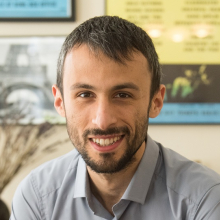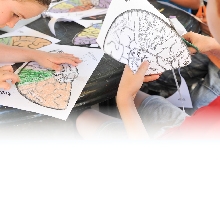Bridging the discovery gap
A new tech transfer program shepherds research projects into the marketplace
Features

Death Valley, in California’s Mojave Desert, is one of the hottest places on Earth. It’s also the nickname for the treacherous stretch between the point at which a scientist makes a discovery and the point at which a product—a drug or technology—is ready for commercialization. It’s an apt epithet: With most investors looking for a quick return on their investment for a sure thing, an insight from a basic research lab is usually a tough sell.
While examples abound of Weizmann Institute success stories of discoveries that evolved into therapies, devices and other products, the landscape for attracting investors has become markedly more competitive. But now a new program launched by Yeda Research and Development Co., Ltd., the Institute’s technology transfer arm, is bridging the gap between basic science breakthroughs and commercial application: the Innovation Development, Enhancement, and Acceleration (IDEA) Program to ensure that the most promising laboratory discoveries from the Weizmann Institute are translated into practical use—quickly and efficiently.
Weizmann scientists are credited with inventing amniocentesis, blockbuster drugs for multiple sclerosis, nano-sized materials and compounds for industrial and medical uses, advanced computer technology, and breakthrough data-storage options. Since 1959, Yeda has successfully promoted the commercial development of Weizmann discoveries, entering into hundreds of agreements with prominent investment groups and several major international corporations.
However, the landscape for commercialization has changed dramatically in the last 30 years. Engaging the interest of venture capital firms, pharmaceutical companies, and technology firms to invest in so-called “high-risk/high-reward” projects has proven tougher and tougher. Commercial entities often consider new insights from the lab too early-stage and of too-uncertain financial promise for consideration.
The IDEA evolution
Yeda has experimented with various tactics to address the so-called ‘valley of death’ between academia and industry. The IDEA program evolved to bridge the gap by identifying new insights from Weizmann labs, and then systematically asking questions such as: What is the commercial potential of this finding? What experiments or prototypes would be of interest to a commercial entity? Companies also want to know how crowded a particular niche of the market is, what patents or additional knowledge are needed to prepare the science for “sale,” how will a company measure success, and what kind of patient population will this finding potentially serve.
IDEA is run by Prof. Eli Hazum, who has extensive experience working with basic research scientists and in the business world. Regularly shuttling between those two worlds, he is also Partner and CSO at Medica Venture Partners, and has previously served as Head of Metabolic Diseases at GlaxoSmithKline in Israel and as a CEO and consultant at several biotechnology firms. The program has a three-pronged approach: creating new intellectual property (IP), upgrading existing IP to strengthen the patent position, and developing and stimulating projects towards commercialization. IDEA uses a variety of business and financial analyses, handles outsourcing solicitations to contract research organizations and contract manufacturing organizations (CROs and CMOs), and recommends necessary pharmacological and toxicological tests. Prof. Hazum and project manager Dr. Neta Pessah work with the scientists to establish milestones and evaluate progress.
“The IDEA program really is designed to improve and broaden patent protection and shorten the development process towards commercialization,” says Prof. Hazum.

Dreaming up good ideas: L-R, Gil Granot-Mayer, CEO of Yeda; IDEA director Prof. Eli Hazum; and IDEA project manager Dr. Neta Pessah
Stories of success
IDEA supports up to 13 projects per year, three to five of which are new. Following recommendations from Yeda’s business unit, or through an annual call for proposals throughout the Institute, proposed projects are first reviewed by an internal panel of Yeda staff, and then by an external panel of selected industry executives, as well as representatives from venture capital firms. In special cases, Yeda’s board provides an additional review.
Once the projects most likely to benefit from commercialization assistance are identified, the two-person IDEA team works with the relevant scientists and Yeda’s business and patent experts to build a development plan with designated milestones aimed at enhancing the project’s successful commercialization. Some projects may entail management by external industry experts, and Yeda’s Board of Directors may request quarterly status reports in certain instances. In this way, the IDEA program complements Yeda’s activities, leading to quick and effective commercialization.
“With IDEA’s activities, we aim to create a new framework for doing internal R&D that ensures that Weizmann Institute discoveries become new products that have real, measurable, and improved opportunities to benefit humanity,” says Gil Granot-Mayer, CEO of Yeda.
A series of projects have already received investor funding after an incubation period under IDEA. Successful “graduates” include:
A start-up established by BioLeaders: Pioneering research by Prof. Moshe Oren and Prof. Varda Rotter led the way towards the realization that p53—the most important tumor suppressor gene—and mutations to it instigate a cascade of events leading to uncontrolled cell proliferation and, eventually, cancer. Newly developed p53-reactivating peptides and peptide-mimetics were shown to cause regression of very aggressive tumors in several cancer models. Unlike most conventional anti-cancer treatments, which activate the p53 pathway and thus have little effect on tumors harboring mutant-p53 forms, the p53-reactivating peptides are capable of restoring its function. The goal is to optimize the peptide-mimetic drugs, which are more appealing to the pharmaceutical industry. BioLeaders, a Korean company, in collaboration with Yeda, established an Israeli company to develop p53 drugs, with an investment of $10 million.
PIs: Prof. Moshe Oren and Prof. Varda Rotter, Department of Molecular Cell Biology
On-Sight: A joint venture between the Weizmann Institute of Science and New York University, involving a system, method, and computer-accessible medium for detecting anatomical anomalies via ultrasound. The objective is to develop and test hand-held ultrasound devices in humans. The company was established in 2018 with a seed investment of $2 million, and it is currently working to obtain approval for cardiologic use from the U.S. Food and Drug Administration.
PI: Prof. Yaron Lipman, Department of Computer Science and Applied Mathematics
Antibody for treating age-related diseases: An early-stage project focused on the production of antibodies capable of tagging and targeting specific cell-surface markers that are present on cells that have stopped dividing (so-called senescent cells). The idea is to use these antibodies to eliminate those cells, as a therapeutic approach for age-related diseases, including pulmonary fibrosis. A start-up company was established by Explore Bio (a collaboration among M Ventures, Arkin Bio Holdings, Pontifax, and WuXi AppTec), and a licensing agreement has been signed.
PI: Prof. Valery Krizhanovsky, Department of Molecular Cell Biology
Kiralis: A ‘chiral’ molecule is one with an asymmetric geometry, such that it comes in both a ‘left-handed’ and ‘right-handed’ configuration. These two mirror images often exhibit significantly differences in chemical behavior, despite being otherwise identical in composition. The technology is an outgrowth of a Weizmann Institute-Hebrew University of Jerusalem discovery involving the application of magnetic fields to separate out a mixture of mirror-image molecules, based on a property called chiral-induced spin selectivity. The goal is to develop a separation method that can be used to improve the safety and effectiveness of a range of chemical products, from pharmaceuticals to fragrances. Kiralis was established with seed investments of over $3 million from Grove Ventures, an Israeli VC.
PI: Prof. Ron Naaman, Department of Biological and Chemical Physics
Donors
Prof. Valery Krizhanovsky is supported by Marlene and Bruce Kanter, the Ilse Katz Institute for Material Sciences and Magnetic Resonance Research, the Jeanne and Joseph Nissim Center for Life Sciences Research, the Quinquin Foundation, the Rising Tide Foundation, the Sagol Institute for Longevity Research, and the European Research Council.
Prof. Yaron Lipman is supported by the European Research Council.
Prof. Ron Naaman is supported by the Edmond de Rothschild Foundations, the John Templeton Foundation, and the European Research Council.
Prof. Moshe Oren is supported by the Dr. Miriam and Sheldon G. Adelson Medical Research Foundation, the Comisaroff Family Trust, the Joel and Mady Dukler Fund for Cancer Research, the Moross Integrated Cancer Center, the Rising Tide Foundation, and Anat and Amnon Shashua. He is the incumbent of the Andre Lwoff Professorial Chair in Molecular Biology.
Prof. Varda Rotter is supported by the Thomas and Jeanne Elmezzi Private Foundation, Phillip Garoon, Richard J. Pratt, and Manya and Adolph Zarovinsky.








